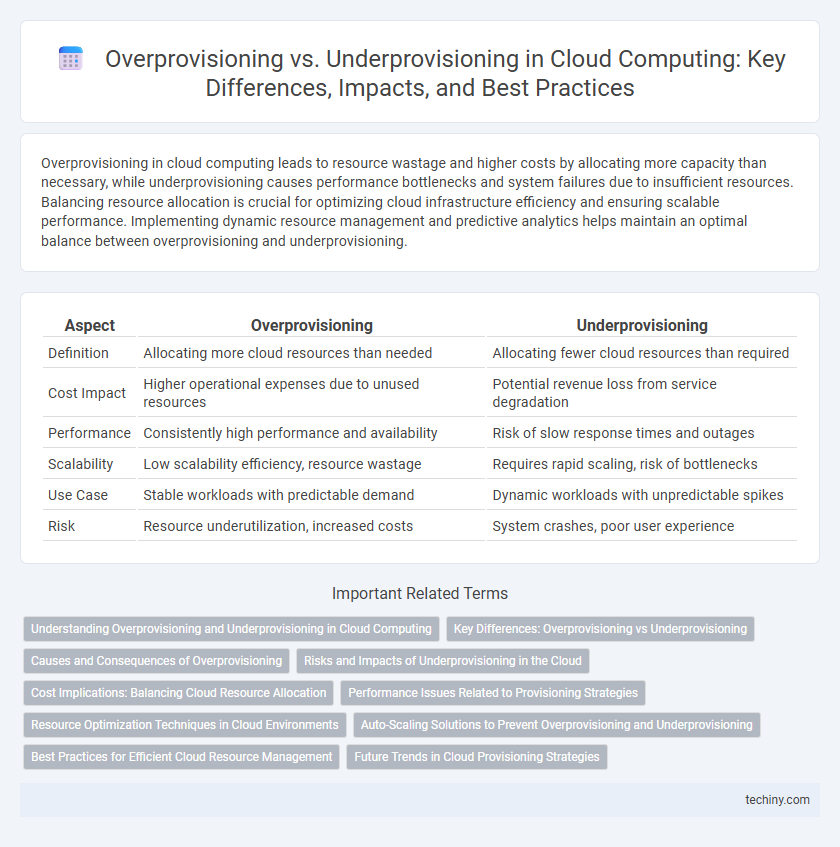Overprovisioning in cloud computing leads to resource wastage and higher costs by allocating more capacity than necessary, while underprovisioning causes performance bottlenecks and system failures due to insufficient resources. Balancing resource allocation is crucial for optimizing cloud infrastructure efficiency and ensuring scalable performance. Implementing dynamic resource management and predictive analytics helps maintain an optimal balance between overprovisioning and underprovisioning.
Table of Comparison
| Aspect | Overprovisioning | Underprovisioning |
|---|---|---|
| Definition | Allocating more cloud resources than needed | Allocating fewer cloud resources than required |
| Cost Impact | Higher operational expenses due to unused resources | Potential revenue loss from service degradation |
| Performance | Consistently high performance and availability | Risk of slow response times and outages |
| Scalability | Low scalability efficiency, resource wastage | Requires rapid scaling, risk of bottlenecks |
| Use Case | Stable workloads with predictable demand | Dynamic workloads with unpredictable spikes |
| Risk | Resource underutilization, increased costs | System crashes, poor user experience |
Understanding Overprovisioning and Underprovisioning in Cloud Computing
Overprovisioning in cloud computing involves allocating more resources than necessary, leading to increased operational costs and potential waste of computing power. Underprovisioning, conversely, results in insufficient resources that cause performance bottlenecks and degraded user experience. Balanced resource management ensures optimal cloud infrastructure utilization, reducing costs while maintaining application performance and scalability.
Key Differences: Overprovisioning vs Underprovisioning
Overprovisioning in cloud computing involves allocating more resources than necessary, leading to higher costs and underutilization, while underprovisioning results in insufficient resources, causing performance degradation and potential downtime. Overprovisioning ensures reliability and availability at the expense of efficiency, whereas underprovisioning risks service interruptions and user dissatisfaction due to resource scarcity. Balancing resource allocation optimizes cost management and system performance, making capacity planning and monitoring critical in cloud environments.
Causes and Consequences of Overprovisioning
Overprovisioning in cloud computing occurs when resources such as CPU, memory, or storage are allocated beyond actual demand, often caused by inaccurate workload forecasting or attempts to avoid service outages. This leads to increased operational costs due to wasted infrastructure and inefficient energy consumption within data centers. Excess resource allocation can also result in scalability challenges and reduced return on investment (ROI) for cloud service providers and enterprises.
Risks and Impacts of Underprovisioning in the Cloud
Underprovisioning in cloud computing leads to resource shortages, causing degraded application performance and increased latency. This results in potential downtime, negatively affecting user experience and enterprise reputation. The insufficient allocation of compute, memory, or storage resources also elevates the risk of missed service level agreements (SLAs) and revenue losses.
Cost Implications: Balancing Cloud Resource Allocation
Overprovisioning in cloud computing leads to inflated costs due to excess capacity that remains unused, increasing operational expenses without proportional benefits. Underprovisioning results in performance bottlenecks and potential revenue loss from downtime or slow service delivery, indirectly driving up total cost of ownership. Effective cloud resource allocation balances these risks by leveraging predictive analytics and auto-scaling to optimize cost efficiency and service reliability.
Performance Issues Related to Provisioning Strategies
Overprovisioning in cloud computing leads to resource wastage but ensures consistent performance by avoiding bottlenecks during peak demand. Underprovisioning causes performance degradation, increased latency, and potential service outages due to insufficient computational resources. Effective provisioning strategies balance cost-efficiency with dynamic workload demands to optimize system responsiveness and reliability.
Resource Optimization Techniques in Cloud Environments
Overprovisioning in cloud computing leads to resource wastage and increased operational costs, while underprovisioning results in performance bottlenecks and service degradation. Effective resource optimization techniques utilize dynamic scaling, predictive analytics, and workload balancing to align resource allocation with actual demand. Leveraging machine learning models and automated orchestration tools enhances efficiency, ensuring optimal utilization and minimizing both overprovisioning and underprovisioning risks.
Auto-Scaling Solutions to Prevent Overprovisioning and Underprovisioning
Auto-scaling solutions in cloud computing dynamically adjust resource allocation based on real-time demand, effectively preventing overprovisioning and underprovisioning. These tools use metrics such as CPU utilization, memory usage, and network traffic to automatically scale instances up or down, ensuring optimal performance and cost efficiency. By leveraging predictive analytics and automated policies, auto-scaling maintains service reliability while minimizing wasted resources.
Best Practices for Efficient Cloud Resource Management
Effective cloud resource management requires precise capacity planning to balance overprovisioning and underprovisioning. Implementing automated monitoring tools enables real-time analysis of resource utilization, preventing costly overcapacity or performance bottlenecks from insufficient resources. Adopting scalable, on-demand provisioning models and leveraging predictive analytics helps optimize costs while maintaining application performance and user experience.
Future Trends in Cloud Provisioning Strategies
Future trends in cloud provisioning emphasize dynamic, AI-driven resource allocation to reduce costs and improve performance by predicting demand patterns with machine learning algorithms. Hybrid and multi-cloud strategies gain traction, enabling seamless scaling to prevent overprovisioning while avoiding underprovisioning risks during traffic spikes. Edge computing integration further refines provisioning accuracy by processing data closer to users, minimizing latency and optimizing resource distribution in real-time.
Overprovisioning vs Underprovisioning Infographic

 techiny.com
techiny.com